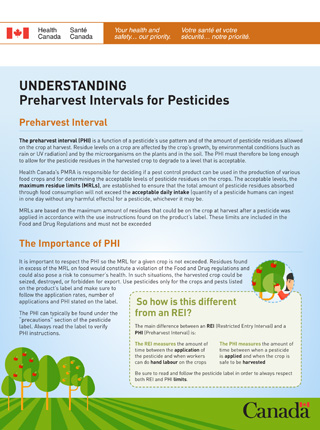Understanding Preharvest Intervals for Pesticides
Preharvest Interval
The preharvest interval (PHI) is the minimum amount of time between the last application of a pesticide and when the crop can be harvested. Harvest is the cutting of the crop or removal of the produce from the plant.
The PHI is found on the pesticide label. Complying with a PHI is a legal requirement. A PHI provides growers with the information required to ensure that residues in the treated produce will not exceed the maximum residue limit (MRL).
An MRL represents the maximum amount of pesticide residues that are expected to remain on a food product when the pesticide is used according to label directions. The MRL is legally established, and regulated under the Pest Control Products Act (PCPA), only once Health Canada’s scientific assessment determines that the consumption of the treated food products will not be a concern to human health.
The Importance of PHI
It is important to respect the PHI so the MRL for a given crop is not exceeded. Residues found in excess of the MRL on food would constitute a violation of the Food and Drug Act and could also pose a risk to consumer health. In such situations, the harvested crop could be seized, destroyed, or forbidden for export. Use pesticides only for the crops and pests listed on the product’s label and make sure to follow the application rates, number of applications and PHI stated on the label.
The PHI can typically be found under the “directions for use” section of the pesticide label. Always read the label to verify PHI instructions.
How a PHI is different from an REI
The main difference between an REI (restricted-entry interval) and a PHI, is that the REI is the amount of time between the application of the pesticide and when workers can do hand labour tasks on the crops. The PHI is the minimum amount of time between the last application of a pesticide and when the crop can be harvested.
Be sure to read and follow the pesticide label in order to always respect both the REI and PHI.
Questions and Answers on PHI
What do I do if the instructions on the pesticide label do not include a PHI?
If the use instructions on a pesticide label do not have a PHI, crops may be harvested at maturity. Be sure to follow any REI listed on the label when harvesting.
If it starts raining following a pesticide application, can I reduce the PHI? And what if I use application rates below those found on the products label, or apply pesticides in bands?
Always follow the PHI required on the label. Not respecting the stated intervals on pest control labels could constitute a health risk and is, therefore, prohibited.
If I apply more than one pesticide that has different preharvest or restricted-entry intervals at the same time (in a tank mix), which interval do I choose?
To observe the established MRLs for pesticides in your crop, you must always chose the longest PHI and REI found on the labels of all the pesticides that were used in the tank mix.
If my crop is going to be stored for a long time or if it is destined for processing, do I still need to respect the PHI?
Preharvest intervals must always be respected. The various factors that affect the residues on treated crops over time (including plant growth, weather conditions, soil microorganisms, etc.) are considered during PMRA’s human health assessment. MRLs are established for harvested and processed commodities; they are set according to the residue level that is expected to be found on the crop at the farm gate.
Not respecting the PHI could lead to a crop having residues in violation of the MRLs. This could constitute an unacceptable risk to consumers and a potential financial loss for the grower.
Is the PHI applicable to the harvest of animal feed items?
For animal feed/forage crops, labels will specify pregrazing intervals (the period between the last application of a pesticide and the grazing of animals; PGI), or feeding restrictions (intervals for cutting feed items such as hay, forage, and straw).
What is considered harvest? Does it include cutting or gathering of the crop?
For some crops, the term “harvest” may be unclear due to differing practices. The PHI is the number of days between the last pesticide application and harvest. In this context, harvest for cereals, oilseeds and grasses, includes direct-combining, cutting (swathing) or grazing; it does not include swathing and combining afterwards, or baling for hay. While residues may continue to dissipate in the crop following harvest, the PHI is based on cutting and not post-cutting activities.
More questions? Call us at the Pest Management Information Service
1-800-267-6315 or pmra.info-arla@hc-sc.gc.ca
